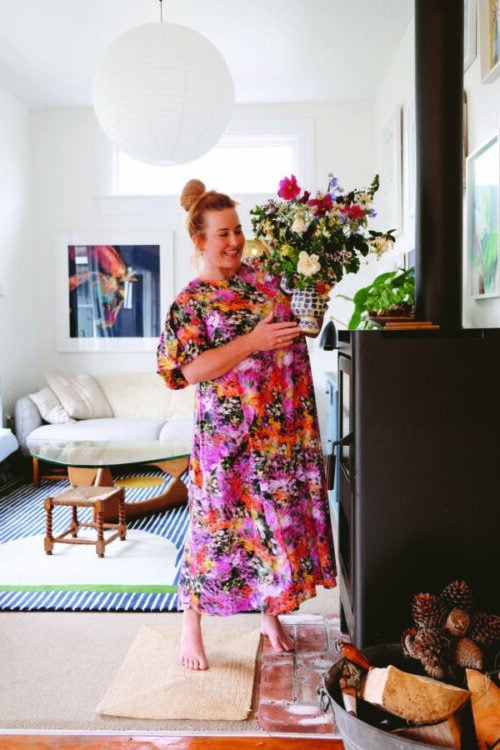Ōtautahi-based creative and gardening enthusiast Julia Atkinson-Dunn shares some sage advice
from her new book Flowers for Friends.
Despite my former disinterest in growing them, cut flowers and foliage were always in my life. From the rescued petunias my toddler sister stamped on, to the pressed herbs I filed away in a scrapbook while investigating options for being a witch, even at a young age I took joy from items plucked from the garden. The kitchen table was never without its central, colourful vase from the garden and trips to the city sometimes involved stopping at the cemetery to lay little home-grown posies to past family.
Living in Auckland as an adult I found it difficult to not swipe offerings that hung over fences, and I often screeched to a halt for side-of-the-road missions to collect rosehips in Central Otago. Bringing these fleeting natural moments into the house to take up residence by my desk or bed is a ritual that has always been with me, but it wasn’t until I started growing plants myself that I realised it was a ritual that fed my happiness.
Whether you are a gardener yourself, an enthusiastic forager or someone who enjoys a trawl of their mum’s borders, there is calm, refuge and creativity to be found in arranging.
I have joked about my passion for flower arranging as being incredibly old-fashioned. That unless you are a florist it kind of sounds like an older person’s sport. What I have come to realise is that our lives have sped up, our home plots are smaller and taking 30 minutes out of a day to gently rove with secateurs in hand can seem frivolous. All the discussion around mindfulness and self-care seems to rest in meditation apps, exercise and face masks. Yet the time I spend harvesting and arranging imperfect home-grown stems to be enjoyed for a fleeting moment is one of the most impactful things I have done for my own wellbeing.
Harvesting from the garden means short and wonky stems, bruised petals, insects crawling out of blooms, and the open invitation to claim a weed or vege as vase fodder. Unlike the demands that florists are under to produce perfection, we at home are only out to please ourselves, or if they are lucky, our friends.

Tips for arranging at home:
- Stem height vs vase height
While this is not always possible, I try to loosely follow the rule that my overall arrangement will be 1–1.5 times taller and bigger than the vase it is housed in. I consider this when taking into account the possible height that can be achieved with the stems I have, followed by which vase would be suitable to enable this balance. If unsure, hold the stems up to your vase selection to work out the best match. - Where will it be seen
When arranging, you have the choice to create in reflection of how the vase will be viewed. I often make up vases that are ‘party at the front, business at the back’, as I know I will be displaying them on a mantelpiece against a wall. If you are making an arrangement to be viewed from all sides (360 degrees), make sure you regularly turn the vase as you build, creating a balanced spread of stems. This doesn’t mean it is totally spherical, just that there is interest and viewing comfort from all points. - Keep it casual and off-centre
As a home arranger, I have found it easier to create with asymmetry and looseness in mind. This gives the just-picked vibe and steps away from any comparison with pristine, traditional arrangements. To achieve this, I often aim to have my tallest bloom off to one side, and balance this with a lower trailing or swooping accent on the opposite side. This has a natural see-saw effect. Flowers are given space to breathe and be seen, particularly around the edges and top line of the arrangement. - Mapping the shape
Using foliage or my most voluminous plant type, I add stems to create an overall outline of what I want the arrangement to follow. From here I continue adding stems, usually working from the most to least of each plant type I have, commonly leaving my smallest and daintiest stems until last so they don’t get squashed. This method works particularly well for arrangements that might be sitting with their back against a wall, viewed only from the front and sides. - Outside in
With this method, beginning again with foliage or the most voluminous stems I have, I thread around the rim of the vessel, before slowly building up and inward. This method works particularly well when making an arrangement that will be viewed from 360 degrees, common to central table settings. - Go with the flow
Wonky, wayward and curly stems cannot be negotiated with! Simply hold the bendy stem against your developing arrangement, see where its natural swoop would fit best and thread it in.
Excerpt and photo from Flowers for Friends by Julia Atkinson-Dunn, Koa Press, RRP$44.95
